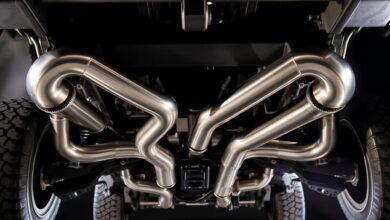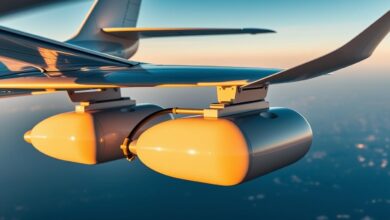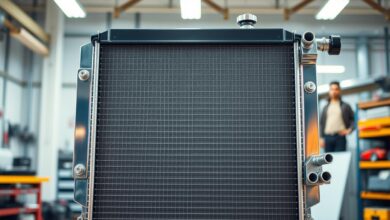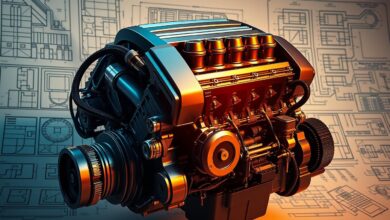Upgrade Your Turbo Setup with Reliable Intercooler Kits
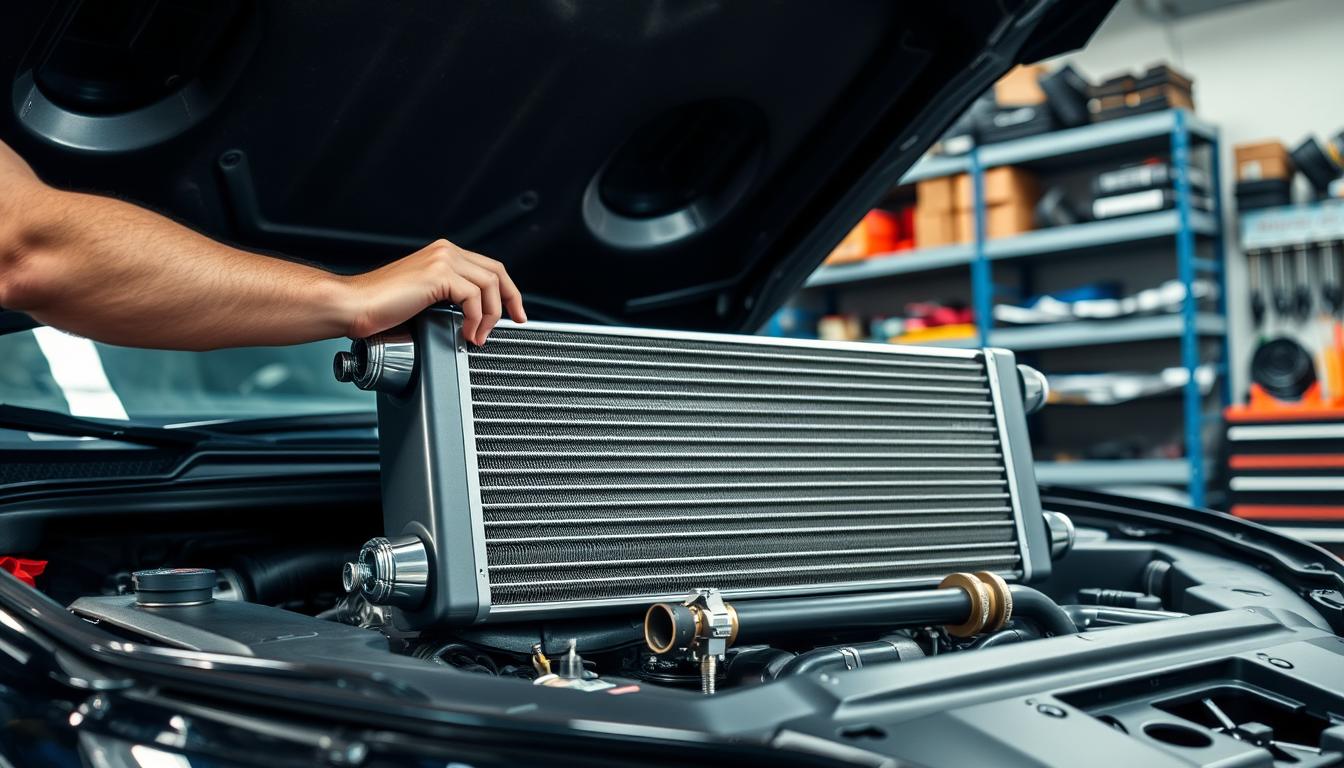
Are you getting the most out of your turbocharged engine? If not, you might be wondering what’s holding you back. The truth is, more boost means more heat. Heat is the enemy of engine performance.
An aftermarket intercooler kit can help. It reduces the air temperature before it hits your engine. This can make your engine perform better and more efficiently. In fact, a good intercooler kit is key for anyone wanting to maximize their turbocharged engine’s power.
With a top-notch intercooler kit, you get cooler, denser air. This leads to more power and less chance of engine knock.
Key Takeaways
- Intercooler kits reduce heat and increase engine performance.
- A reliable intercooler kit is essential for turbocharged engines.
- Aftermarket intercooler kits can significantly increase power output.
- Cooler air charges result in reduced risk of engine knock.
- High-quality intercooler kits maximize turbocharged engine’s power.
Why Upgrading Your Intercooler is Crucial
Upgrading your intercooler can greatly improve your turbocharged engine’s performance and efficiency. An intercooler cools the air compressed by the turbo before it reaches your engine. This is done by sitting between the turbocharger and the intake manifold.
The Role of Intercoolers in Turbocharged Engines
The intercooler is key to your turbocharged engine’s success. It cools the air, making it denser and more efficient. This can boost performance significantly. It also reduces the risk of engine knock or pinging, which can harm your engine.
Benefits of a High-Quality Intercooler
Choosing a high-performance intercooler brings many advantages. It improves engine performance, boosts power output, and makes your engine more reliable. A top-notch intercooler cools air better, helping your engine work more efficiently. For more details, check out this page.
- Increased power output due to denser air-fuel mixture
- Improved engine efficiency and reliability
- Reduced risk of engine knock or pinging
Signs Your Current Intercooler is Underperforming
Look out for signs like decreased engine performance, higher engine temperature, or visible damage. An underperforming intercooler can lead to lower engine efficiency and damage over time.
| Signs of Underperformance | Description |
|---|---|
| Decreased Engine Performance | Noticeable drop in engine power and responsiveness |
| Increased Engine Temperature | Engine temperature gauge showing higher than normal readings |
| Visible Intercooler Damage | Leaks, cracks, or other forms of damage to the intercooler |
Knowing how intercoolers work and spotting underperformance can help you boost performance with intercoolers. It also keeps your engine in top shape.
Understanding Intercooler Types
To upgrade your turbo setup, knowing about intercooler types is key. Intercoolers cool the air charge from the turbo, making it denser. This boosts engine performance.
There are mainly two types: air-to-air and air-to-water. Air-to-air intercoolers cool air using ambient air and cooling fins. This method is simple and works well, thanks to the car’s motion or fans.
Air-to-Air vs. Air-to-Water Intercoolers
Air-to-air intercoolers are known for their ease and reliability. They’re simpler and cheaper than air-to-water systems. Yet, their cooling depends on the air and temperature.
Air-to-water intercoolers use liquid to cool the air charge. They cool better, which is great for high-performance or when air flow is low.
Comparing Efficiency and Performance
When comparing air-to-air and air-to-water intercoolers, several factors matter. Air-to-air systems are easy to install and keep up. Air-to-water systems cool better, which is good for high-boost or hot conditions.
For more on intercooler science, check out Banks Power’s article on the science of.
Choosing the Right Type for Your Setup
Choosing the right intercooler depends on your car, performance needs, and driving conditions. For a simple, cost-effective option, an air-to-air might be best. For top performance, an air-to-water system could be better.
Knowing the pros and cons of each type is key. This helps you pick the best upgrade for your turbo engine. By matching your needs with the right intercooler, you’ll boost your engine’s performance and reliability.
Key Features to Look for in Intercooler Kits
Choosing the right intercooler kit is key for your turbocharged engine’s efficiency. A good kit cools and densifies the air for your engine. This boosts your vehicle’s performance.
Core Size and Material
The core size of an intercooler kit is vital. It affects how well it cools the air. A bigger core cools better but might need more space and make installation harder.
The core material is also important. Aluminum is often used because it conducts heat well.
Think about your car’s space and engine cooling needs when picking a core size. Also, check the kit’s build quality for durability and performance.
Fin Design and Flow Characteristics
The fin design in an intercooler kit is key to its efficiency. Fin designs like bar-and-plate or tube-and-fin affect cooling and airflow. Your engine’s layout and performance needs guide your choice.
- Bar-and-plate designs cool well and are for high-performance.
- Tube-and-fin designs balance cooling and airflow, fitting many engines.
Compatibility with Your Turbo System
It’s critical that the intercooler kit fits your turbo system. Check the kit’s specs against your turbo’s needs, like boost pressure and airflow. A good match ensures your engine gets the best air, boosting performance and safety.
For compatibility, talk to the kit maker or a mechanic. They can check your system and suggest the best kit for you.
Focus on core size, material, fin design, and system compatibility when picking an intercooler kit. This ensures your vehicle’s performance improves. Whether you want a simple upgrade or top performance, the right kit is essential.
Popular Brands for Intercooler Kits
In the world of turbocharged engines, a top-notch intercooler kit is key. Several leading brands offer solutions for various needs and tastes. Upgrading your turbo setup with a reliable intercooler kit from a trusted brand can greatly improve your vehicle’s performance.
Mishimoto: Performance and Reliability
Mishimoto is a respected name in the car world, known for quality intercooler kits. Their products boost performance and reliability. Mishimoto’s kits are built for efficient cooling, improving your car’s performance and life span.
Garrett: Proven Technology in Turbo Systems
Garrett is a leading brand in turbocharging and intercooler tech. With years of experience, Garrett’s kits offer matched performance that fans trust. Their focus on research keeps their products at the cutting edge of turbo tech.
AEM: Innovative Solutions for Enthuasiasts
AEM is known for innovation and quality, with a range of intercooler kits for performance lovers. Their kits provide superior cooling efficiency and are built to last. AEM’s kits are a top pick for turbo engine upgrades, thanks to their reliability and performance.
Choosing an intercooler kit means looking at the brand’s reputation and product quality. Mishimoto, Garrett, and AEM are industry leaders, providing aftermarket solutions that boost your vehicle’s performance. Opting for a reputable brand ensures your turbocharged engine gets a high-quality kit that meets your needs.
Installation Process for Intercooler Kits
Installing an intercooler kit needs careful planning and attention to detail. Before starting, know the steps and tools needed for a smooth process.
Tools You’ll Need for Installation
You’ll need various tools for the job. These include a socket set, wrenches, and maybe a drill for custom mounts. Make sure you have everything before you start to avoid delays.
- Socket set
- Wrenches (adjustable and fixed)
- Drill (if required for custom mounting)
- Other kit-specific tools
Step-by-Step Installation Guide
Here’s a step-by-step guide to install your intercooler kit:
- Prepare your workspace: Clear a flat surface and gather all tools and the kit.
- Disconnect the negative battery cable to prevent accidental starts.
- Remove the existing intercooler: Disconnect hoses and electrical connectors, then remove the mounting hardware.
- Install the new intercooler kit: Mount the new intercooler, reconnect hoses and electrical connectors, and secure with the provided hardware.
- Tighten all connections and check for leaks.
Common Mistakes to Avoid
Installing an intercooler kit can be tricky. Common mistakes include not tightening connections properly, misaligning the intercooler, and failing to check for leaks. A seasoned mechanic once said,
“A good installation is not just about following the manual; it’s about understanding the why behind each step.”
Knowing these common mistakes can help you avoid them. This ensures a successful installation.
Optimizing Performance After Installation
Now that your new intercooler kit is in, it’s time to tweak it for the best boost performance with intercoolers. To get the most out of your turbocharged engine, follow a few key steps. These steps will help you enjoy the full benefits of your new setup.
Testing and Tuning Your New System
Start by testing and tuning your intercooler system. Look for leaks or any issues in the installation. A boost leak test kit can help spot problems that might affect your boost pressure.
- Check all connections and hoses for wear or damage.
- Use a data logging tool to track your engine’s performance and find areas to improve.
- Adjust your engine’s tuning to work best with your new intercooler kit.
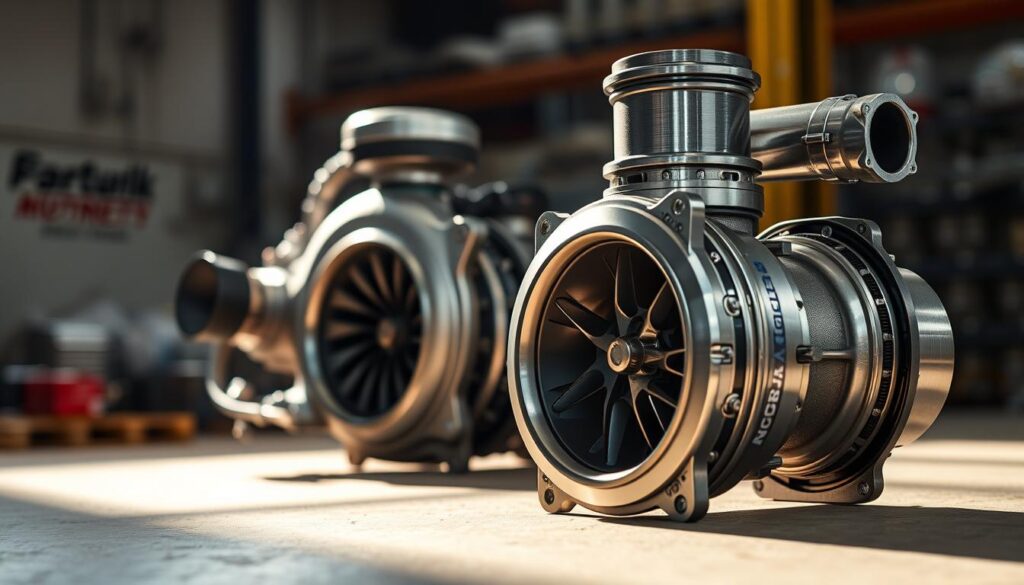
Monitoring Engine Temperature and Boost Levels
It’s important to watch your engine’s temperature and boost levels after installing a new intercooler kit. High temperatures can harm your engine’s performance and safety. Make sure your cooling system is working right and your intercooler is cooling the intake air effectively.
- Keep an eye on your dashboard gauges for engine temperature and boost pressure.
- Use a scan tool to check for trouble codes about engine temperature or boost pressure.
- Adjust settings as needed to keep your engine at the right temperature and boost levels.
Adjusting Other Turbo Components for Harmony
To get the best from your new intercooler kit, you might need to tweak other turbo parts. This could mean upgrading your wastegate or adjusting your fuel system to match the increased airflow.
For example, if you’ve got a bigger turbocharger, you might need to adjust your engine’s tuning for the higher boost pressure. Also, if you’re using a high-performance intercooler, you might need a better coolant system to handle the heat.
By following these steps and making sure all parts work well together, you can maximize your new intercooler kit’s performance. This will give you a more responsive and powerful drive.
Maintenance Tips for Your Intercooler Set-Up
Keeping your intercooler in top shape is key for the best engine performance. A well-kept intercooler means your turbocharged engine runs smoothly. This gives you a better driving experience.
Regular Inspection and Cleaning
It’s important to regularly check your intercooler. Look for any damage like cracks or dents. These can harm its performance. Also, cleaning it with a mild detergent and water helps remove dirt and debris from the fins.
- Check for physical damage or leaks.
- Clean the intercooler with appropriate cleaning solutions.
- Ensure all connections are secure and not damaged.
Identifying Potencial Leaks and Damage
Leaks and damage can really hurt your intercooler’s efficiency. Always check it and its connections for leaks or damage. For more tips on keeping your intercooler and turbo pipes in good shape, check out forums like TDIC Club.
Upgrading Components as Needed
As you upgrade your turbo setup, you might need to update your intercooler too. Look into high-performance intercoolers that can handle more boost and airflow.
- Check if your current intercooler meets your engine’s needs.
- Find intercooler kits that fit your turbo system.
- Get advice from experts if you’re not sure about upgrades.
By sticking to these maintenance tips, your intercooler setup will keep supporting your turbocharged engine’s performance and life.
Frequently Asked Questions About Intercoolers
Looking to boost your turbocharged car’s performance? Knowing about intercoolers is essential. We’re here to answer your top questions.
How Do I Know If I Need a New Intercooler?
Feeling your car’s performance drop? Seeing engine temps rise? Spotting leaks? It might be time for a new intercooler. Regular checks can catch problems early.
- Watch for any drops in your car’s performance.
- Look for leaks or damage on the intercooler.
- Think about how your driving affects your intercooler’s work.
Can I Install an Intercooler Myself?
Yes, many DIY fans install intercoolers successfully. But, it needs thorough planning and the right tools. Make sure to follow a step-by-step guide and get help if you’re not sure.
- Get all the tools and parts ready before you start.
- Use a trusted guide for your car’s model.
- Test your system well after you’ve installed it.
What’s the Average Cost of an Intercooler Upgrade?
The price for upgrading your intercooler varies a lot. It depends on the intercooler type, brand, and installation complexity. Expect to spend between $300 and $1,500 or more for a top-notch kit.
It’s key to weigh cost against quality. Choose a reliable, efficient intercooler that fits your car’s needs.
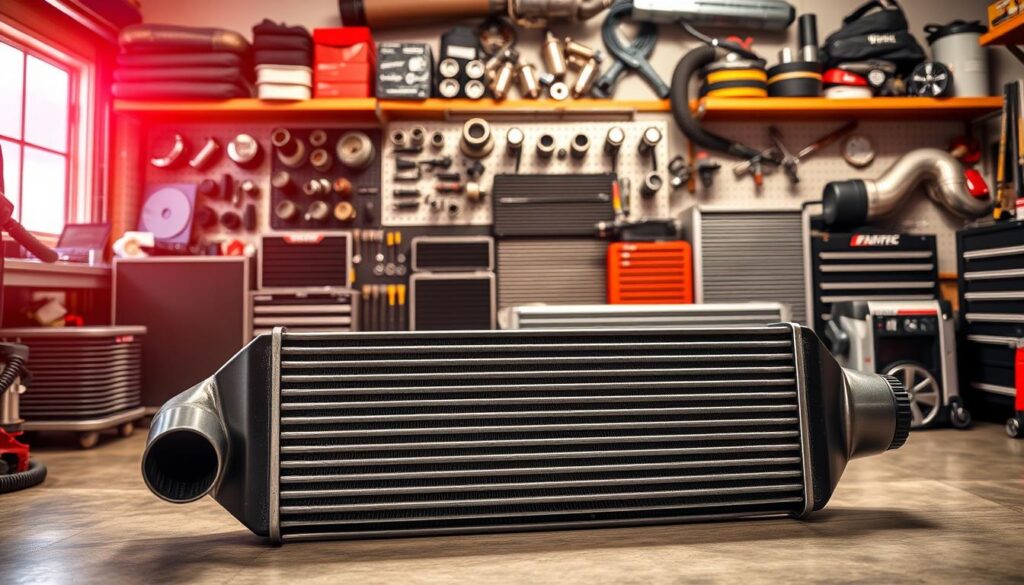
Understanding your intercooler needs and exploring upgrade options can lead to better choices. These choices can improve your car’s performance and lifespan.
Conclusion: The Worthwhile Investment in Your Turbo Setup
Upgrading to an aftermarket intercooler can really boost your turbo setup’s performance and life span. By getting a reliable intercooler kit, you’re making a key move to better your engine’s efficiency and power.
Boosting Performance and Durability
Aftermarket intercooler solutions cool better, keeping your turbocharged engine safe. This boosts performance and makes your engine parts last longer.
Becoming Part of the Turbo Enthuasiast Community
Choosing to upgrade your intercooler means you’re joining a group of enthusiasts who love high-performance and reliability. You can now explore more upgrades and modifications to boost your vehicle’s abilities.
Moving Forward with Confidence
With your new intercooler kit, you’ll see better boost levels, cooler engine temperatures, and a more responsive drive. Take the next step in improving your turbo setup and check out the range of aftermarket intercooler solutions out there.
FAQ
What is the primary function of an intercooler in a turbocharged engine?
An intercooler cools the air from the turbocharger before it hits the engine. This helps avoid engine knock and boosts engine performance.
How do I know if my current intercooler is underperforming?
Look out for signs like lower engine performance, higher engine temperature, and less boost pressure. You might also see fuel efficiency drop or turbo lag increase.
What are the differences between air-to-air and air-to-water intercoolers?
Air-to-air intercoolers cool air with ambient air. Air-to-water intercoolers use liquid coolant. Air-to-air is simpler and cheaper, while air-to-water cools better and is used in high-performance cars.
Can I install an intercooler kit myself, or do I need professional help?
You can install an intercooler kit yourself if you have mechanical skills and follow the instructions. But, if you’re unsure, it’s safer to get a professional mechanic to do it.
What are some key features to look for when selecting an intercooler kit?
Look for a large core size, high-quality materials, and efficient fin design in an intercooler kit. Make sure it fits your turbo system and engine components well.
How often should I inspect and clean my intercooler?
Check your intercooler every 12,000 to 15,000 kilometres and clean it as needed. This keeps it working well and prevents engine damage.
What’s the average cost of an intercooler upgrade?
The cost of an intercooler upgrade varies. It depends on the kit’s type, quality, and installation complexity. Expect to pay between 0 and ,000 or more for a good kit.
Are aftermarket intercooler kits reliable?
Many aftermarket intercooler kits are reliable, with some brands even giving warranties. But, it’s important to pick a reputable brand for a quality product.
How do I optimize performance after installing a new intercooler kit?
After installing a new intercooler kit, test and tune your engine. Monitor engine temperature and boost levels. Adjust turbo components as needed for the best performance.

